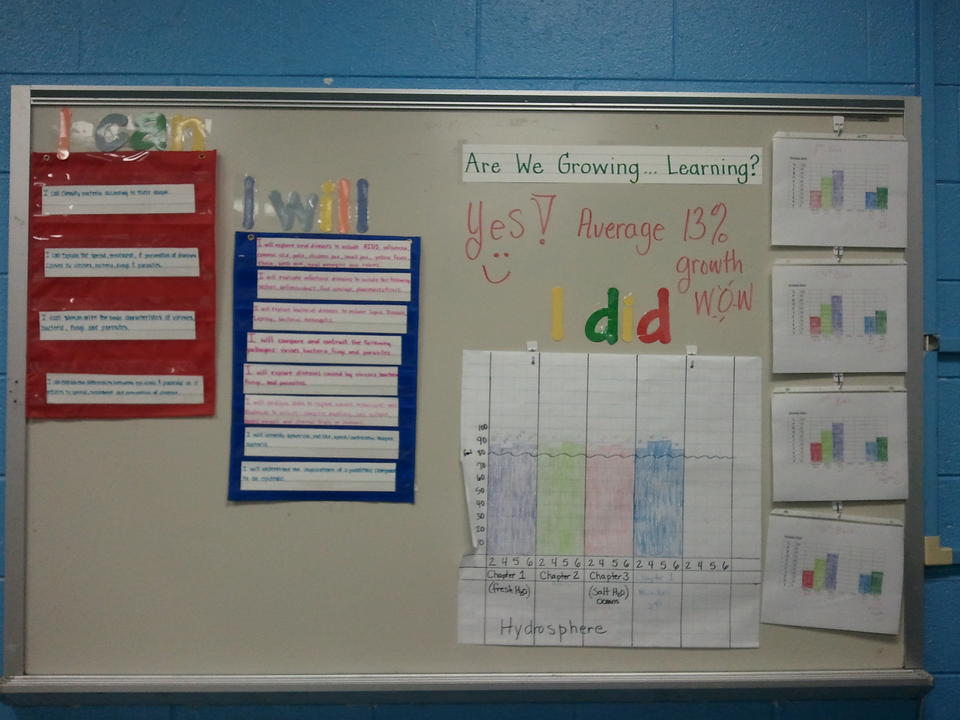Blogrige
The Official Baldrige Blog

An I-SS classroom display shows an example of sharing improvements with students. Photo used with the permission of Iredell-Statesville Schools.
We have previously highlighted the continued progress in recent years of the Baldrige Award-winning Iredell-Statesville Schools (I-SS) of southwestern North Carolina.
Among economic challenges that the 21,000-plus student district had faced over the previous five years, we noted, “Cuts in tax-based funding have amounted to millions shaved from annual education budgets. And the number of students poor enough to qualify for free and reduced-price school lunches has risen from 35 percent to just under 45 percent of the student population.”
Yet the district is still enhancing and maintaining improvements in wide-ranging performance areas. It does so by adhering to a systems perspective and other aspects of the Baldrige excellence framework it adopted 13 years ago.
I-SS has provided inspiration and guidance to struggling school systems around the country by sharing its story and practices. Therefore, we recently asked for another update from Melanie Taylor, I-SS Deputy Superintendent of Curriculum and Instruction.
Taylor illuminated how public school districts can benefit from using the Baldrige framework for excellence despite the heightened poverty of U.S. schoolchildren today and other economic and social challenges: “As public schools are facing more and more challenges through increased competition and declining budgets, using the Baldrige Criteria can help districts work smarter with fewer resources,” she said. Baldrige-using districts accomplish this, she explained, “by examining key processes to help determine what’s working and what needs to be improved or eliminated altogether.”
“As a district, we’ve been able to maintain market share and increase or maintain performance while [tax-based] resources and budgets have continued to decline,” she added. “By gathering feedback even from those who choose to leave our district, we’ve been able to make improvements to the organization.”
According to Taylor, such feedback “has indicated a need to increase rigor and choice in the district.” In response, over the last six to seven years I-SS has expanded “choice options” for students, including early college programs, career academies, dual-immersion language programs, and the International Baccalaureate program, despite declining budgets.
This expansion has been possible through alignment of district resources and processes, she explained. Referring to her district’s continued use of the Baldrige Education Criteria for Performance Excellence since its 2008 Baldrige Award, Taylor said, “It’s always a challenge to keep the focus. You have new staff or board members that don’t understand because they don’t have the background in continuous improvement. You continually have to on-board staff with the ‘why we do this.’”
Taylor pointed out that the accountability and sharing of control that are expected in the district “make some uncomfortable.” Yet on a hopeful note, she added, “Most folks get it once they’ve seen it in action and see the positive results.”
Among those results, I-SS has sustained dramatic improvements since 2002 on measures such as its high school graduation rate, student performance on SAT tests, state academic ranking, and percentages of highly qualified and National Board-certified teachers. I-SS also has improved its financial and budgetary results, in part by winning large grants in recent years to support student learning.
For example, Taylor affirmed that I-SS is one of just seven school districts in the nation to receive a $5 million federal i3 grant, which required a $1 million private match, and that it is one of 16 districts nationwide to receive a $20 million “Race to the Top” federal grant. Taylor further noted that I-SS is the only public school district in the country to have received both of those federal grants.
Taylor offered the following three tips to other school districts exploring or beginning to implement the Baldrige framework to improve systemwide performance:
1. Adopt continuous improvement at all levels of the organization: “You can gain more traction (sustainability) by implementing throughout all levels instead of just management,” said Taylor. “In I-SS, we use PDSA [Plan-Do-Study-Act process improvement method] with five-year-olds.”
2. Continually focus on “why we do this” and the positive results: “Help folks understand why you’re doing what you’re doing so you gain more buy-in,” stressed Taylor.
3. Engage everyone in improvement efforts: “Start by having different levels identify a problem that they think needs improving. It might not be what senior leadership would see as a problem, but if those at that level of the organization see it as a problem to address and can be a part of the solution, they’re more apt to buy in later on,” Taylor noted.
Taylor encourages educators and others to attend her district's best-practice sharing presentations to “come see and learn how the PDSA cycle is utilized by teachers at the classroom level to engage students, increase learning, and drive instructional improvement.”
About the author
Related Posts
Comments
- Reply





